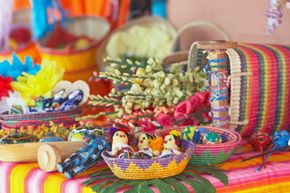Crafting is big business. A Craft and Hobby Association report released for 2010 places consumer spending on craft-related products at around $29 billion annually. That's a lot of yarn, scrapbooking paper and decorative buttons. If you're a crafter, this may not come as much of a surprise. There are lots of crafts around, and an interest in one, like scrapbooking, can easily lead to an interest in a related craft like paper making, stenciling or art quilting.
Crafting can be more than a weekend pastime, too. Selling crafts and craft supplies is one way to make a little money working from home, and sites like Etsy.com that cater to the crafting market make the goal of selling finished crafts more of a functional reality for artisans.
Advertisement
Craft sites also help establish crafting communities where beginning crafters can learn more about their areas of interest and share their love of personal expression with others. The Internet has become a kind of electronic quilting bee for many crafters. Budding artists can communicate across large distances, make projects together, display their works in community forums, or donate their efforts to worthy charities across the globe. From a practical perspective, that means your mother-in-law doesn't have to appreciate your homemade lampshades (quilts, picture frames or silk flower arrangements). Someone who thinks they're great (and would probably like a brief tutorial on how to make them) is just a mouse click away.
The computer age has changed the nature of many crafting pursuits. An electronic embroidery machine or stencil cutter may make creating the perfect gift a lot easier, but all that technological wizardry comes at a price. A high-end embroidery/sewing machine can cost $10,000, and that's just the machine and not the designs and materials -- all the neat stuff that's so important to many crafters.
From ribbons to paper to silk flowers, crafting is about the stuff. That's not so hard to understand, either. The more pretty fabrics, decorative papers and charming designs a crafter has access to, the more his or her inner artist can flourish. But those bags, boxes and bins of stuff can quickly overrun a closet, dedicated craft room or basement studio.
Good craft management means periodic culling -- or discarding items you no longer need (or think you may no longer need, or figure you no longer need as much of). It can be a painful process, but your loss is someone else's gain if you occasionally participate in a craft supply swap. The reverse can also be true. You can pick up a few enticing extras while reducing some of the clutter in your crafting space at the same time. If the idea is intriguing, swaps are not that hard to arrange. They're also a great way to make new friends and celebrate crafting in all its many variations.
On the next few pages, let's take a look at what's involved in hosting a craft supply swap. From choosing a theme to knocking out the small details, this is one craft-related project that's bound to be a big success.
Advertisement


